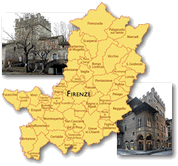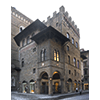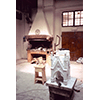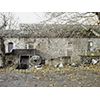Florence and its Plain - The Weaving Art

At the origin of Florence’s economic power in the Middle Ages were the Merchant and Crafts Guilds, the headquarters of which were concentrated in and around the area today known as the Loggia del Porcellino. Among these, which included the Guilds of Wool Workers, Bankers and Silk Weavers, the powerful Wool Merchants Guild stood out in particular.
[Given the limitations on traffic in the historical centre, we advise you undertake the first legs of the proposed itinerary on foot]
Of the original headquarters of the Silk Weavers Guild, there remains today only the name of the street where it was located. The new headquarters on Via del Capaccio, is instead clearly recognisable by the coat of arms over the main door.
The Silk Weavers Guild or of Por Santa Maria was born in the late 12th century with the rise of the other guilds, in the area of the Piazza del Mercato Nuovo (New Market), today known as Loggia del Porcellino. In this area were concentrated the headquarters of the richest and most powerful merchant guilds, such as those of Wool Workers, Wool Merchants and Moneylenders. In addition to merchants, bankers were also particularly active in this area; indeed, in 1421 there were 72 banks here. The original headquarters of the Por Santa Maria Guild was located in the street that still today carries its name: around 1313, a workshop was rented here and adorned with a tabernacle containing the image of the Virgin Mary and two Saints. Towards the end of the 14th century, the headquarters in Via del Capaccio was purchased, and is still recognisable today for the Guild’s coat of arms over the main door.
(Antonella Gozzoli)
Nearby is the palazzo of the Wool Merchants Guild, which abounds in works of art, including an interesting fresco depicting several phases of wool making.

Built in the late 13th century by the powerful Wool Merchants Guild, whose headquarters it was as of 1308, as testified by a walled plaque, the building is formed by a tower-house adjoined by a lower construction. Its interior conserves fourteenth-century frescoes and it is connected with Orsanmichele by means of an overpass built in 1569 on a project by Bernardo Buontalenti. In the early 21th century, the palazzo was subjected to considerable renovation, and became headquarters of the Dante Society. Particularly interesting is the fourteenth-century fresco portraying several phases of wool working (today located in a shop on Via Calimala).
The Wool Merchants Guild developed a highly flourishing industry: in its period of greatest splendour, with its more than 300 workshops that worked more than 100,000 bolts of fabric per year, it employed one-third of the active population of Florence. The raw wool was beaten and washed; then it was rinsed in the Arno and laid out to dry on wicker trellises. After drying and combing, the "carders" proceeded to soften it: at this point, the wool was woven by women, even in their homes. The final operations were those concerning the delicate process of dyeing.
The wool industry was also tied to the exploitation of alum mines. This mineral made it possible to fix a dye on fabric by means of a procedure in which the Florentine workshops excelled, the secret of which has been lost. Genoa which had the monopoly on the diffusion of alum in Europe, imported it from Asia Minor until the Ottoman conquest made it necessary to find other supply sources. In 1461, a new deposit was found in Tolfa, situated about seventy kilometres northwest of Rome: the Medici succeeded in obtaining exploitation rights, but in 1476 the rights were acquired by their rivals, the Pazzi.
(Antonella Gozzoli)
Another interesting testimony of the importance this manufacturing activity had in fourteenth-century Florence is the panel on Giotto’s Bell Tower nearby, depicting The Art of Weaving by Andrea Pisano, the original of which is presently conserved in the Museo dell’Opera di Santa Maria del Fiore.

The Opera di Santa Maria del Fiore was born in 1296 with the foundation of the new Cathedral, and its administration passed to the Wool Merchants Guild in 1331. Since its foundation, the Opera has been an independent lay institution with the task of attending to the Cathedral patrimony. Since then, it has preserved the complex and, by an agreement with the Chapter of the Florentine Metropolitan, attends to the expenses of worship. In 1777, a grand-ducal decree entrusted the Opera also with the Baptistery and various other buildings. With the Concordat of 1929, the Institution assumed the status of "Fabbriceria" (works commission).
The Museum was instituted in 1891 to preserve the artefacts not housed inside the Cathedral, along with various objects remaining from the work site. In 2001, the Museum was restructured and the collections received new layouts. The scientific artefacts Opera is entrusted with also include the medieval solstice marble of the Baptistery, the mechanical clock, the gnomons of the Cathedral, and various materials used for experiments on the rotation of the earth in the 19th century.
The collection comprises various pieces of work site equipment (hoists, lifts, hempen ropes, etc.) and scientific instruments, which can be dated as of the Middle Ages, and are exhibited in the Museum’s "Brunelleschi’s Work Site" room, along with wooden models of the Cathedral.
On the top floor of the Museum is the study room for the visually impaired, containing reproductions of works and models that can be handled by visitors.
(Carlo Triarico)
Before concluding the itinerary with a visit to one of the manufactories tied to the production of wool in Florence, we suggest a stop at the Fondazione Arte della Seta Lisio, which conserves ancient looms and fabrics, alongside modern workshops and a specialised library. Located outside the centre of Florence, to get there, take Lungarno del Tempio, cross the Giovanni da Verrazzano Bridge and proceed on past Viale Giannotti.
The Foundation was instituted in 1971 by Fidalma Lisio, daughter of Giuseppe Lisio who in 1907 founded one of the best-known manufactories of hand-woven silk in Italy, with the task of preserving the old manufacturing techniques.
The Foundation conserves a collection of looms and one of antique fabrics and technical drawings. The collection of looms includes early twentieth-century handlooms, some of them functioning, built according to the Renaissance typology, with the sole addition of a system of perforated cards of nineteenth-century conception for changing register, to enable a single worker to operate the machine. The collection of antique fabrics and technical drawings includes some 350 antique silk fabrics, most of which date between the 17th and 18th century, and the technical drawings of the old Lisio manufactory, used for weaving.
Teaching is conducted in a computer workshop, used for designing textile patterns, and in two workshops equipped with handlooms. Part of the handlooms has been adapted to teaching needs: the Fondazione school has six Jacquard looms, one for each textile typology: lampases, damasks, velvets, double warp fabrics.
The Foundation also has a library specialised in textile techniques and history, and conserves a small collection of photographs of the early 20th century and a collection of autograph letters by Gabriele D’Annunzio, Giuseppe Lisio and Giņ Ponti.
(Carlo Triarico)
From Via Benedetto Fortini, turn back towards Florence, turn right onto Viale Europa, and take SP34 more or less up to the town of Sieci. Here looms the characteristic outline of the Remole Fulling Mills, one of the most important industrial plants of the area in the Middle Ages.

In the Middle Ages, mills were at the basis of a complex production system and therefore of trade and economic development. There were many in the city of Florence, on its outskirts, and in other cities of Tuscany. The small mills in the countryside ground grain, while the large plants activated mechanisms capable of cutting trees and stones, crushing olives, making paper, and working wrought iron using hammers.
Along the course of the Arno were complex production plants made up of ten or more mills, a barrage or weir, made on the river bed in order to raise the level of water, and a canal or millrace, necessary to get the water to reach the mills.
Numerous fulling-mills were located, for example, in Rovezzano, Girone, Quintole and Remole. Fulling-mills were used for the first time in England in the middle of the 11th century. Their mechanics was based on a large horizontal cylinder, driven by a water wheel on which a row of staggered sprockets imparted an alternating movement to a series of hinged rods which thus tamped down the woollen fabrics inside vats, and also provided a heating action. The mechanisation of the fulling process was the evident signal of the great development attained by manufactories in the 14th century.
One of the most important fulling-mill plants, created around the mid 14th century, was the one in Remole, situated along the course of the Arno, in correspondence to the town of Sieci. The fulling-mills of Remole constitute one of the few still existing examples of an industrial factory of the late-medieval epoch in Italy, which at the same time documents the development attained by the wool manufacture of Florence. The entire complex of its hydraulic works has remained substantially unaltered.
Property of the Albizzi, Rucellai and Valori families, in 1541 the building at Remole was purchased by the Wool Merchants Guild, which conducted the activity of the fulling-mills until 1728 when, following its suppression, the facilities became property of Santa Maria del Fiore. In the Napoleonic age, the fulling-mills of Remole were taken over by the Chamber of Commerce of Florence. Today they are property of the Commune of Florence, though sited on the territory of Bagno a Ripoli.
(Anna Toscano)
****************************
Texts by Elena Fani
English translation by Victor Beard
Last update 07/feb/2008



 = libraries and archives
= libraries and archives  = scientific research centers
= scientific research centers  = memorial places of scientists
= memorial places of scientists = public health places
= public health places = places of science and worship
= places of science and worship = places of technology
= places of technology  = museums and collections
= museums and collections  = villas and gardens of science
= villas and gardens of science


